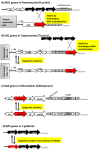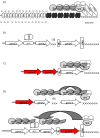Parasite epigenetics and immune evasion: lessons from budding yeast
- PMID: 24252437
- PMCID: PMC3843538
- DOI: 10.1186/1756-8935-6-40
Parasite epigenetics and immune evasion: lessons from budding yeast
Abstract
The remarkable ability of many parasites to evade host immunity is the key to their success and pervasiveness. The immune evasion is directly linked to the silencing of the members of extended families of genes that encode for major parasite antigens. At any time only one of these genes is active. Infrequent switches to other members of the gene family help the parasites elude the immune system and cause prolonged maladies. For most pathogens, the detailed mechanisms of gene silencing and switching are poorly understood. On the other hand, studies in the budding yeast Saccharomyces cerevisiae have revealed similar mechanisms of gene repression and switching and have provided significant insights into the molecular basis of these phenomena. This information is becoming increasingly relevant to the genetics of the parasites. Here we summarize recent advances in parasite epigenetics and emphasize the similarities between S. cerevisiae and pathogens such as Plasmodium, Trypanosoma, Candida, and Pneumocystis. We also outline current challenges in the control and the treatment of the diseases caused by these parasites and link them to epigenetics and the wealth of knowledge acquired from budding yeast.
Figures


Similar articles
-
Sneaking Out for Happy Hour: Yeast-Based Approaches to Explore and Modulate Immune Response and Immune Evasion.Genes (Basel). 2019 Aug 31;10(9):667. doi: 10.3390/genes10090667. Genes (Basel). 2019. PMID: 31480411 Free PMC article. Review.
-
CRISPR Interference of a Clonally Variant GC-Rich Noncoding RNA Family Leads to General Repression of var Genes in Plasmodium falciparum.mBio. 2020 Jan 21;11(1):e03054-19. doi: 10.1128/mBio.03054-19. mBio. 2020. PMID: 31964736 Free PMC article.
-
Patterns of co-speciation and host switching in primate malaria parasites.Malar J. 2009 May 22;8:110. doi: 10.1186/1475-2875-8-110. Malar J. 2009. PMID: 19463162 Free PMC article.
-
Host immune evasion strategies of malaria blood stage parasite.Mol Biosyst. 2017 Nov 21;13(12):2498-2508. doi: 10.1039/c7mb00502d. Mol Biosyst. 2017. PMID: 29091093 Review.
-
Plasmodium falciparum erythrocyte invasion: combining function with immune evasion.PLoS Pathog. 2014 Mar 20;10(3):e1003943. doi: 10.1371/journal.ppat.1003943. eCollection 2014 Mar. PLoS Pathog. 2014. PMID: 24651270 Free PMC article. Review.
Cited by
-
Architecture, Chromatin and Gene Organization of Toxoplasma gondii Subtelomeres.Epigenomes. 2022 Sep 15;6(3):29. doi: 10.3390/epigenomes6030029. Epigenomes. 2022. PMID: 36135316 Free PMC article.
-
Forks on the Run: Can the Stalling of DNA Replication Promote Epigenetic Changes?Front Genet. 2017 Jun 22;8:86. doi: 10.3389/fgene.2017.00086. eCollection 2017. Front Genet. 2017. PMID: 28690636 Free PMC article. Review.
-
Histone methylation changes are required for life cycle progression in the human parasite Schistosoma mansoni.PLoS Pathog. 2018 May 21;14(5):e1007066. doi: 10.1371/journal.ppat.1007066. eCollection 2018 May. PLoS Pathog. 2018. PMID: 29782530 Free PMC article.
-
Subtelomeric Transcription and its Regulation.J Mol Biol. 2020 Jul 10;432(15):4199-4219. doi: 10.1016/j.jmb.2020.01.026. Epub 2020 Feb 6. J Mol Biol. 2020. PMID: 32035903 Free PMC article. Review.
-
Genomic characterization of variable surface antigens reveals a telomere position effect as a prerequisite for RNA interference-mediated silencing in Paramecium tetraurelia.mBio. 2014 Nov 11;5(6):e01328. doi: 10.1128/mBio.01328-14. mBio. 2014. PMID: 25389173 Free PMC article.
References
LinkOut - more resources
Full Text Sources
Other Literature Sources
Molecular Biology Databases

